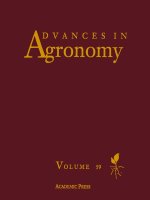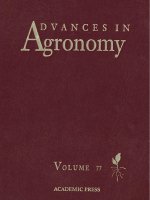(Advances in heterocyclic chemistry 45) alan r katritzky (eds ) advances in heterocyclic chemistry academic press (1989)
Bạn đang xem bản rút gọn của tài liệu. Xem và tải ngay bản đầy đủ của tài liệu tại đây (13.51 MB, 359 trang )
Advances in
Heterocyclic
Chemistry
Volume 45
www.pdfgrip.com
Editorial Advisory Board
R. A. Abramovitch, Clemson, South Carolina
A. Albert, Canberra, Australia
A. T. Balaban, Bucharest, Romania
A. J. Boulton, Norwich, England
H. Dorn, Berlin, G.D.R.
J. Elguero, Madrid, Spain
S. Gronowitz, Lund, Sweden
T. Kametani, Tokyo, Japan
0. Meth-Cohn, South Africa
C. W. Rees, FRS, London, England
E. C . Taylor, Princeton, New Jersey
M. TiSler, Ljubljana, Yugoslavia
J. A. Zoltewicz, Gainesville, Florida
www.pdfgrip.com
Advances in
HETEROCYCLIC
CHEMISTRY
Edited by
ALAN R. KATRITZKY, FRS
Kenan hfessor of Chemistry
Department of Chemistry
university of Florida
Gainesville. Florida
n
Volume 45
ACADEMIC PRESS, INC.
Harcourt Bmce Jovanovich, Publishers
San Diego New York Berkeley Boston
London Sydney Tokyo Toronto
www.pdfgrip.com
COPYRIGHT 0 1989 BY ACADEMIC PRESS, INC.
All Rights Reserved.
No part of this publication may be reproduced or transmitted in any form or
by any means, electronic or mechanical, including photocopy. recording, or
any information storage and retrieval system, without permission in writing
from the publisher.
ACADEMIC PRESS, INC.
San Diego, California 92101
United Kingdom Edition published by
ACADEMIC PRESS LIMITED
24-28 Oval Road, London NW I 7DX
LIBRARY OF CONGRESS CATALOG CARD NUMBER:
62-13037
ISBN 0-12-020645-5 (alk. paper)
PRINTED IN THE UNITED STATES OF AMERICA
~
Y
Y
~
Y
I 9Y n ~ 7 6 5 4 . 3 2 1
www.pdfgrip.com
Contents
PREFACE
......................................................................
vii
Chiral Induction Using Heterocycles
EIICHIFUJITA
AND YOSHIMIT~U
NAGAO
.
I Introduction ..........................................................
I1. Preparation of CCChiral Thiazolidine-2-thionesand Oxazolidine-2-thiones ...
I11. C h i d Recognition in Aminolysis ........................................
IV Analytical Separation and Optical Resolution of
Racemic Carboxylic Acids and Amino Acids ..............................
V Highly Diastereoselective AldoL’Ilpe Reactions ............................
VI . Highly Selective Nonenzymatic Chiral Induction onto
Prochiral a-Symmetric Dicarboxylic Acids ................................
VII Methylseleno-Promoted Ketene-Imine Cycloaddition Reaction ...............
VIII Conclusion ...........................................................
References ............................................................
.
.
.
.
1
2
4
6
1
22
30
33
33
Heterocyclic Quinones
MIHATISLER
I.
I1.
111.
IV.
V.
VI .
VII.
.
VIII
IX.
Introduction ..........................................................
Quinones with a Condensed Four-Membered Heterocyclic Ring ..............
Quinones with a Condensed Five-Membered Ring with One Heteroatom......
Quinones with a Condensed Five-Membered Ring with W o Heteroatoms .....
Quinones with a Condensed Five-Membered Ring with Three Heteroatoms ...
Quinones with a Condensed Six-Membered Ring ..........................
Quinones with W o Different Heterocyclic Systems
Attached to the Quinone Moiety ........................................
Miscellaneous Heterocyclic Quinones .....................................
Appendix .............................................................
References ................................................
...........
V
www.pdfgrip.com
38
39
39
14
82
84
118
121
122
124
vi
CONTENTS
The Chemistry of Thiophenium Salts and Thiophenium Ylids
.
E. A PORTER
ALEXANDER
I . Introduction ..........................................................
I1. S-Alkylated Thiophenes ................................................
I11 Thiophene S.C-Ylids ...................................................
IV. Thiophene S,N-Ylids ...................................................
V Conclusions...........................................................
References ............................................................
.
.
.
152
153
159
176
182
182
1 CDiazocines
HOWARD
D PERLMUTTER
.
.
.
.
.
I Scope and Nomenclature ...............................................
I1 Preparative Methods ...................................................
I11 Theoretical and Structural Studies .......................................
IV Reactions .............................................................
V. Applications ..........................................................
References ............................................................
185
187
209
217
223
224
Recent Advances in Azomethine Y lide Chemistry
OTOHIKO
TSUGE
AND
SHUJI KANEMASA
.
.
.
.
I Introduction ..........................................................
I1. Generation ............................................................
111 Cycloadditions ........................................................
IV. Intramolecular Cycloadditions ...........................................
V Natural Product Synthesis ..............................................
VI Conclusion ...........................................................
References ............................................................
www.pdfgrip.com
232
233
295
333
337
343
344
Volume 45 of Advances in Heterocyclic Chemistry contains five contributions, all of which break new ground for this series. In the first article, Fujita
and Nagao describe the use of heterocycles for the induction of chirality. This
contribution represents an example of the way in which our subject is making itself increasingly felt throughout the whole field of chemistry. The second
article, by Tiger, covers heterocyclic quinones, including the many classes in
which a heterocycle is fused to a 1,2- or 1,4-benzoquinone ring.
In the third article, Porter describes the chemistry of thiophenium salts
and ylids, to which he has contributed extensively. The chemistry of
1,4-diazocinesis presented by Perlmutter; this article follows an earlier review
by the same author on azocines in Volume 31 of Advances in Heterocyclic
Chemistry.The final article of this volume, and the second contribution from
Japan, is by Tsuge and Kanemasa and deals with recent advances in
azomethine ylide chemistry.
The cumulative index updates, as announced in the preface to Volume 40,
will cover Volumes 41-45 and will appear in Volume 46. This will prevent a
delay in the publication of Volume 45.
ALANR. KATRITZKY
www.pdfgrip.com
This Page Intentionally Left Blank
www.pdfgrip.com
.
ADVANCES IN HETEROCYCLIC CHEMISTRY VOL. 45
Chiral Induction Using Heterocycles
EIICHI FUJITA
Osaka University of Pharmaceutical Sciences. Matsubara 580. Japan
YOSHIMITSU NAGAO
.
Institute /or Chemical Research. Kyoto University Uji. Kyoto-fu 61I. Japan
I . Introduction . . . . . . . . . . . . . . . . . . . . . . . .
I I . Preparation of C4-Chiral Thiazolidine-2-thiones and Oxazolidine-2-thiones .
111. Chiral Recognition in Aminolysis . . . . . . . . . . . . . . . .
IV . Analytical Separation and Optical Resolution of
Racemic Carboxylic Acids and Amino Acids . . . . . . . . . . . .
V . Highly Diastereoselective Aldol-Type Reactions . . . . . . . . . . .
A . Aldehydes . . . . . . . . . . . . . . . . . . . . . . . .
1.Outline . . . . . . . . . . . . . . . . . . . . . . . .
2. Synthetic Applications: Chiral Azetidinones and Virginiamycin M1 . .
B. 4-Acetoxy-2-azetidinones . . . . . . . . . . . . . . . . . .
1.Outline . . . . . . . . . . . . . . . . . . . . . . . .
2. Synthetic Application: Carbapenems . . . . . . . . . . . . .
C. 5-Acetoxy-2-pyrrolidinone and 6-Acetoxy-2-piperidinone . . . . . . .
1. Outline . . . . . . . . . . . . . . . . . . . . . . . .
2. Synthetic Application: Bicyclic Alkaloids . . . . . . . . . . .
VI . Highly Selective Nonenzymatic Chiral Induction onto
Prochiral u-Symmetric Dicarboxylic Acids . . . . . . . . . . . . .
A . 3-Methylglutaric Acid . . . . . . . . . . . . . . . . . . . .
B. meso-2,4-Dimethylglutaric Acid . . . . . . . . . . . . . . . .
1.Outline . . . . . . . . . . . . . . . . . . . . . . . .
2. Synthetic Application: ( +)-Prelog-Djerassi Lactonic Acid Methyl Ester .
C . rneso-S-Norbornen-2,3-ylene-end
o-bis(acetic acid). . . . . . . . . .
D . cis-4-Cyclohexen- 1,2-ylenebis(acetic acid) . . . . . . . . . . . .
1.Outline . . . . . . . . . . . . . . . . . . . . . . . .
2. Synthetic Application: ( +)-Carbacyclin . . . . . . . . . . . .
VII . Methylseleno-Promoted Ketene-Imine Cycloaddition Reaction . . . . . .
VIII. Conclusion . . . . . . . . . . . . . . . . . . . . . . . . .
References . . . . . . . . . . . . . .
.
.
1
2
4
.
.
6
7
1
.
.
II
13
7
.
.
.
.
.
.
.
.
.
.
13
16
18
18
19
22
23
24
24
25
26
26
21
21
30
33
33
.
I Introduction
The useful physiological activity of pharmaceuticals containing asymmetric
center(s) appears almost always in only one enantiomer . Hence. an effective
synthesis of the desired enantiomer with optical purity is now an important
Copyright @ 1989 by Academic Press. Inc.
All rights of reproduction in any form reserved.
www.pdfgrip.com
2
EIICHI FUJITA AND YOSHIMITSU NAGAO
[Sec. I1
subject in chemistry. The chiral synthon has been obtained by (1) asymmetric
chemical synthesis, (2) synthesis of a racemate followed by its optical
resolution, (3) chiral induction in a specific prochiral compound with enzymes
or microorganisms, and (4) chemical transformation from easily available
sugars, amino acids, terpenoids, and other optically active natural products.
In our laboratories, new highly selective asymmetric inductions featuring
the functions of CCchiral thiazolidines and oxazolidines were recently
developed. An overview of these chiral designs, reactions, and applications
will be discussed in this article.
11. Preparation of C6Chiral Thiazolidine-2-thiones and
Oxazolidine-2-thiones
CCChiral thiazolidine-2-thiones were prepared by condensation, as, for
example, (4R)-methoxycarbonyl- 1,3-thiazolidine-2-thione[(4R)-MCTT] (1)
from L-cysteine methyl ester hydrochloride and carbon disulfide (CS,) in
the presence of triethylamine (Et,N) in CH,CI, at room temperature
(Scheme 1) (82TL201; 85JOC4072). The (4s)-enantiomer was similarly synthesized by using D-cysteine methyl ester hydrochloride (85CC1419).
Other C4-chiral oxazolidine-2-thiones. (4s)- (2) and (4R)-ethyl-1,3oxazolidine-2-thione (3) C(4S)- and (4R)-EOT], (4S)-isopropyl-l,3-oxazolidine-2-thione (4), and (4R)-methyl-(5S)-phenyl-1,3-oxazolidine-2-thione
[(4R,SS)-MPOT] (5) were likewise synthesized. Typical preparations of
C4-chiral 1,3-0xazolidine-2-thiones(2-5) from fi-amino alcohols (6-9) are
as follows.
Method A . A mixture of (2S)-aminobutan-l-o1(6) and CS, in the presence
of Et,N in CH,CI, was stirred at room temperature for 4 hr to give (4s)-EOT
(2) in 58.4% yield (Scheme 2) (85JCS(P1)2361).
Method B. A solution of potassium hydroxide in aqueous ethanol was
added to a solution of (+)-norephedrine hydrochloride and CS, in aqueous
ethanol with stirring and ice cooling. The mixture was stirred at 70-80°C for
6 hr. The usual workup gave the desired (4R,SS)-MPOT (5) in 69% yield
(Scheme 2) (85JCS(P1)2361).
-
-t
H%
CI H3h
SH
-&
LO2Me
t_02Me
CS2
H
72.3%
SCHEME
I
www.pdfgrip.com
HNYS
S
Sec. II]
3
CHIRAL INDUCTION USING HETEROCYCLES
R2
R4
Rlji
irR3
H2N
OH
+
cs2
-
R3
HNKo
S
- (9)
(6)
(2)
(2), (6) R1= Et, R2= R3=
(3). ( 7 )
- (5)
R4= H
R1= R3= R4= H, R2= Et
(4). ( 8 ) R1=CHMe2, R2= R3= R4= H
( 5 ) . (9) R1 = R3= H, R2= Me, R4= Ph
SCHEME
2
(4S)-Ethyl-l,3-thiazolidine-2-thione
[(4S)-ETT] (10) and (4S)-isopropyl1,3-thiazolidine-2-thione[(4S)-IPTT] (11) were prepared in 82.5 and 65.3%
yield, respectively, by heating (80-90°C) a solution of the corresponding
amino alcohols [(2S)-amino-l-butanol (12) and (2S)-amino-3-methyl-1butanol(13)l in aqueous ethanol, CS, (2 mol equivalents), and KOH (2 mol
equivalents) (86JOC2391).
The enantiometric purity of these new chiral heterocycles can be determined by high-performance liquid chromatography (HPLC) and NMR
(' H and 19F)analyses of their (R)-(+ )-a-methoxy-a-(trifluoromethy1)phenylacetic acid (MTPA) amides.
(10) R = Et
( 1 2 ) R = Et
( 1 1 ) R = CHMe2
(13) R = CHMe2
The merits of asymmetric synthesis employing C4-chiral thiazolidines
(1, 10, and 11) and oxazolidines (2-5) are as follows. (1) Commercially
available a-amino acids and 8-amino alcohols can be employed for the
synthesis of C4-chiral heterocycles 1-5,10, and 11. (2) The almost-planar fivemembered heterocyclic moiety clearly bisects the CCchirality of the heterocycles. (3) The asymmetric induction should be analyzable by a UV detector
attached to HPLC, because these heterocycles show a strong UV absorption
www.pdfgrip.com
4
EIICHI FUJITA AND YOSHIMITSU NAGAO
[Sec. I11
(n -+ n*)with a high E value. (4) Chiral nucleophilic reactions can be easily
designed by utilizing an active amide structure of N-3-acylthiazolidine-2thiones and oxazolidine-2-thiones (82H537).
111. Chiral Recognition in Aminolysis
A new monitored aminolysis of 3-acyl-l,3-thiazolidine-2-thione
(ATT) has
been developed by the authors (80TL841; 84CPB2687). This procedure has
been applied to syntheses of several macrocylic diamides (80CL159;
81H(15) 1037), macrocyclic spermidine alkaloids (80TL4931; 81CC286),
peptides (81CL463; 84JCS(P1)2439), and a spermidine siderophore,
parabactin (84JCS(P1)183). The rate of the aminolysis was found to be
remarkably affected by steric bulk of the amines. The end point of the reaction
can easily be judged by disappearance of the original yellow color of ATT.
A potential chiral recognition for racemic amines 15 by a chiral ATT derivative 14 was suggested by consideration of the foregoing aminolysis.
Thus, the mixture of a solution of rac-phenylglycine methyl ester in
CH2CI2 and a yellow solution of 3-hexadecanoyl-(4R)-methoxycarbonyl1,3-thiazolidine-2-thione (14a) in the same solvent was stirred at room
temperature in nitrogen until the original yellow color of the medium
vanished. A usual workup gave an optically active amide 16 in 93.7% yield
+ 50.35") based
[enantiomeric excess percent (ee%) = 64.4 (S excess: [a]:'
on the pure amide 161 (82TL201). The N-acylation of (4R)-MCTT (1) was
carried out by its treatment with hexadecanoyl chloride in the presence of
Et,N in tetrahydrofuran (THF) or by treatment of the thallium salt with
hexadecanoyl chloride in THF.
The aqueous layer on usual workup gave optically active phenylglycine
methyl ester hydrochloride in 83.4% yield [ee% = 45.9 (R excess:
[a] If" - 60.59') based on pure (R)-phenylglycine methyl ester hydrochloride:
[a]hO - 132.13'1 (Scheme 3).
Several other examples were summarized by Nagao et al. (82TL201).
Thus a significant chiral recognition was realized in the aminolysis of 3-acyl(4R)-methoxycarbonyl-l,3-thiazolidine-2-thiones
[4(R)-AMCTT] (14) with
racemic amines. In this reaction, (4R)-AMCTT (14) showed a preferential
reactivity to the (S)-amine.
1,3-oxazolidine-2Comparison of the use of 3-acyl-(4S)-methoxycarbonylthione [(4S)-AMCOT] (18) with that of (4R)-AMCTT (14) showed the
superiority of the latter over the former.
The chiral recognition described above is available for the determination of the absolute configuration of a chiral amine. The method is as follows. rac-3-Hexadecanoyl-4-methoxycarbonyl1,3-thiazolidine-2-thione
(rac-
www.pdfgrip.com
~7"
'A
0
C02Me
0
R'
?:
z
+
5
5
CHIRAL INDUCTION USING HETEROCYCLES
Sec. 1111
x H,N+H-->
+
RJ+~,H
s
(14)
X =
(18)
X = 0
H,N+H
+
H
R'
(16)
(racemate)
(S excerr)
-
S
R'
R'
(15)
C_OzMe
!'
R'
17"
(17 )
-
( R excers)
"colorless"
R f < R ' i n sequence r u l e
(14) a : R1= (CH2)14Me
b : R1= Ph
c : R1= CH2Ph
d : R1= 1-adamantyl
SCHEME
3
HDMCTT) (rac-14a) (2 mol equiv) was subjected to aminolysis with 1 mol
equiv of optically active amine (or imine). Then the specific rotation of the
recovered HDMCTT (14a)was determined. By the sign of its specific rotation,
the absolute configuration of the amine (or imine) can be assigned (82TL205).
Aminolyses of rac-14a were tried with several types of amines, i.e., a-amino
acid derivatives, /?-amino alcohols, and 3-amino-B-lactams (Scheme 4).
The results are as follows. In the case of a-amino acid derivatives, the
(S)-enantiomer reacted with (4R)-HDMCTT (14a) preferentially and vice
versa [(R)-enantiomer + (4s)-HDMCTT], which was in good agreement
with the chiral recognition of racemic amine with (4R)-AMCTT (14). In the
case of /?-amino alcohol derivatives, the (S)-enantiomer showed a preferential
reactivity to (4s)-HDMCTT, resulting in the recovery of (4R)-HDMCTT.
In the case of 3-amino-/?-lactams7 (R)-penam-, (R)-cephem-, and (S)oxacephem derivatives all showed a preferential reactivity to (4s)-HDMCTT;
(R)-oxacephem derivatives reacted predominantly with (4R)-HDMCTT.
0
2 x
R'
C0,Me
Me(CH,)l.AN3
SJ-s
(mc- 14a)
+
%H
sAs
0
tM,+H-
Me(CH,)I!"
R'
optically
active
\
RI
0
C0,He
+
R(CHz),uANfH
R' R'
V
optically active
R or S
SCHEME
4
www.pdfgrip.com
COzMe
+ H N 3 H
S&
J
6
[Sec. IV
EIICHI FUJITA A N D YOSHIMITSU NAGAO
TABLE 1
DETERMINATION
OF ABSOLUTE
CONFIGURATION
Chiral amino
derivative
Preferred configuration ( R or S)
of the recovered HDMCTT
Absolute configuration of the
optically active sample
a-Amino acid
derivatives
R(-)
S(+)
bS
P-Amino alcohol
derivatives
N-1
+s
S(+)
t R
{SRlIl
r S
3-Amino-P-lactam
derivatives
Oxacephem and
oxapenam
b
R
> R
’ R
,s
On the basis of these results, the absolute configuration of chiral amines
(or imines) can be determined, as summarized in Table I.
Apparent opposite chiral recognitions with 19 and 20 are attributed only
to the (R,S)sequence rule by Cahn et al. (66AG(E)385).
IV. Analytical Separation and Optical Resolution of
Racemic Carboxylic Acids and Amino Acids
The determination of the enantiometric purity of optically active carboxylic
acids and amino acids is important not only for an evaluation of their
asymmetric syntheses, but optical resolution of racemic modifications of
chiral carboxylic acid derivatives and chiral amino acids is also industrially
important. A separation on both an analytical and a preparative scale of the
racemically modified and commercially available carboxylic acids 21a-24a
and amino acids 25a-27a was attempted by utilizing (4R,SS)-MPOT (5).
The condensations between 5 and the carboxylic and amino acids 21a-27a
were carried out as usual to afford the corresponding 3-acyl-(4R,SS)-MPOT
derivatives 21b-27b. Their analytical separation was readily achieved by
HPLC. ‘H-NMR techniques can also be useful for the analysis of the
diastereoisomeric ratio of amides 21b-27b.
www.pdfgrip.com
Sec. V.A]
CHIRAL INDUCTION USING HETEROCYCLES
MeC H CO R
I
NHC02CHZPh
7
Me-CH-C HCOR
I
I
Me NHC02CH2Ph
C 0 2 C H 2Ph
The optical resolution of racemates 22a,25a,and 27a was carried out by
chromatographic separation of their (4R,SS)-MPOT-arnide derivatives 22b,
25b,and 27b.The absolute stereochemistry of each pure diastereoisomer was
confirmed by comparing the physical data of its derivative with those of the
authentic compound in each case. Thus, (4R,SS)-MPOT (5) proved to be a
satisfactory chiral reagent useful for analytical separation and optical
resolution of racemic carboxylic acids and amino acids (85JCS(P1)2361).
This racemate separation method was applied to synthesis of the 8lactam 29 starting from the commercially available (Z)-DL-Ser-OH (28)
(85JCS(P1)2361).
rfNHHC02CH2Ph
Ho
CO,H
V. Highly Diastereoselective Aldol-Type Reactions
A. ALDEHYDES
1. Outline
A useful diastereoselective synthesis of aldols using chiral 3-acyl- 1,3oxazolidine-Zthiones 30, 31, 34, and 35, was developed. As described in
Section 11, (4R,5S)-MPOT (5)and (4s)-EOT (2)were prepared. These chiral
heterocycles were employed as chiral auxiliaries. As enolating reagents, tin(I1)
www.pdfgrip.com
8
EIICHI FUJITA AND YOSHIMITSU NAGAO
[Sec. V.A
Isolated yield of
L e n o l a t e
Ph
Me
Ph
Me
major product
(81
(30)
R = CHMe2
89.0 (32)
R =
Me
76.3
R
CHZCHMe2
R =
CHMe2
81.8
:
11.0 (33)
68
;
23.7
62
:
18.2
64
91.4
60
8.6
(a) Sn(03SCF312. N-ethylpiperidine, CH&ln
-50
-40 'C
-
SCHEME
5
trifluoromethanesulfonate and N-ethylpiperidine were used according to
Mukaiyama's procedure (83CL297).
Thus, N-ethylpiperidine was added to a suspension of tin(I1) trifluoromethanesulfonate in anhydrous CH,Cl, at - 50°C under Ar. After addition
of a solution of 3-acety1-(4R,SS)-MPOT (30) in CH,Cl,, the mixture was
stirred at -50 to -40°C for 3 hr. A solution of isobutyraldehyde in CH,CI,
was then added at - 78°C and the mixture was stirred at the same temperature
for 20 min. Usual workup of the reaction mixture gave a mixture of
diastereoisomers 32 and 33, the ratio of which was readily checked by
HPLC equipped with a UV detector. Chromatographic separation of each
diastereoisomer gave optically pure 32 and 33 (Scheme 5).
Similar chiral aldol-type reactions using compound 30, 3-acetyl-(4S)-EOT
(31), 3-propanoyl-(4R,5S)-MPOT(M),
and 3-propanoyl-(4S)-EOT (35) gave
fairly high diastereoselectivity (Schemes 5 and 6).
The stereochemical outcome shown in Schemes 5 and 6 can be rationalized
in terms of an assumed transition state 37 (85CC1418). Interestingly, comparison of the transition state 37 involving tin(I1) enolate with that in the
Evans case (8 1PAC1 109) (38)involving boron(II1) enolate shows a remarkable contrast. It is also noteworthy that chiral recognition in the Miller case
(87JOC2201) (39), employing (4R)-MCTT (1) and tin(I1) trifluoromethanesulfonate, was just the opposite to ours.
www.pdfgrip.com
Sec. V.A]
-
y;:tf;eo-
RCHO
-enolate
Ph
9
CHIRAL INDUCTION USING HETEROCYCLES
-78T
Me
($1
Ph He
(34)
Isolated yield of
major p r o d u c t
R = CHMe2
90.5
(36) :
9.5
71
R = Ph
83.5
:
16.3
65
diartereoisomers
R = CHMe2
85.6
:
14.4
74
SCHEME
6
A chiral synthon such as an a-nonsubstituted-/?-hydroxy-y,h-unsaturated
carbonyl compound should be useful for the synthesis of biologically active
natural products, such as virginiamycins, compactin, nystatin Al, borrelidin,
and leucomycins. In spite of its potential utility, no one has reported a chiral
synthesis of any /?-hydroxy-y,h-unsaturated carboxylic acid derivative by an
aldol-type reaction because of its remarkable sensitivity toward base or acid
under the reaction conditions. Asymmetric aldol-type reactions employing
saturated aldehydes and acetyl derivatives have been reported by Evans
(81JA2127), Mukaiyama (83CL297), and the authors (85CC1418). However,
these reaction conditions cannot be used without improvement for chiral
aldol-type reactions with a,/?-unsaturated aldehydes. New C4-chiral 1,3thiazolidine-2-thiones, (4s)-ETT (10) and (4s)-IPTT(1l),were investigated as
chiral auxiliaries. As the enolate-forming reagent, tin(I1) trifluoromethanesulfonate and N-ethylpiperidine, the same system as described above, were
used (Scheme 7). In this reaction, alcohols Ma-e were afforded as major
products in a highly diastereoselective manner (see Table 11) (86JOC2391).
www.pdfgrip.com
10
EIICHI FUJITA AND YOSHIMITSU NAGAO
a:R' = Et
b:R' = i-Pr
a:R'
b:R'
Et,
= Et,
Rz IC +p,,
R* = $H
e Me
c:R'= Et, R2 =
d:R' i-pr, R2 =
AMe
e:R' = i-Pr, R2 =
SCHEME
7
TABLE 11
DIASTEREO-CONTROLLED
ALWL-TYPE
REACTIONS
BETWEEN
(ATT)
C4-CHIRAL 3-ACETYL- I ,3-TH1AZOLlDINE-2-THlONES
AND OL,~~-UNSATURATED
ALDEHYDES
ATT
Aldehyde
40a
41a
Diastereoisomer
selectivityb
92.7: 1.3
Isolated
yield"
(%I
77.0
(44a :45a)
40a
41b
40a
41c
40a
41a
40a
41c
93.1: 6.9
(44b:45b)
88.6:11.4
(44e:45c)
97.1: 2.9
(4
:45d)
97.3: 2.1
(44e:45e)
Total yield of both stereoisomers.
Determined by HPLC analysis (UV, 305 nm).
www.pdfgrip.com
74.2
12.4
81.2
10.2
[Sec. V.A
Sec. V.A]
CHIRAL INDUCTION USING HETEROCYCLES
11
2. Synthetic Applications: Chiral Azetidinones and
Virginiamycin MI
The aldol-type reaction described in Section V,A.1 was applied to the
synthesis of chiral azetidinones 50 and 51 (Schemes 8 and 9).
Alcohol 46, after protection with a t-butyldimethylsilyl (TBDMS) group
to 47, was converted into amide 48 by aminolysis with 0-benzylhydroxylamine
in CHCl, . The amide 48 was desilylated to give N-benzyloxy-(3R)-hydroxybutyramide (49), which was converted into l-benzyloxy-(4S)-methyl-2-azetidinone (50), as shown in Scheme 8 (85CC1418).
A chiral 8-lactam (51) was also synthesized from 44c,as shown in Scheme
9 (86JOC2391).
The second application of this method is concerned with the synthesis of
virginiamycin M 1 (52). Our synthetic strategy consisted of syntheses of four
segments, A, B, C, and D, subsequent condensations between A and B and
between C and D, followed by A-D condensation and final cyclization
between B and C (83TL2287; 83TL2291).
B
segment A ++
segment C
segment D
In the asymmetric syntheses of segments B and C, an aldol-type reaction
is needed. Synthesis of segment C was carried out as follows. As mentioned,
N-propanoyl-MPOT (34)was converted into 36 highly stereoselectively. After
the secondary alcohol was protected as the tetrahydropyranyl (THP) ether, it
was treated with diisobutylaluminum hydride (DIBAL) to give aldehyde 53,
which was subjected to a modified Wittig reaction (Wadsworth-Emmons
modification) to give a trichloroethyl ester, 54, of an a$-unsaturated
carboxylic acid. Deprotection gave finally segment C (55) (Scheme 10)
(83UP1).
Segment B (56) in virginiamycin MI was synthesized as shown in
Scheme 1 1 (86UP1).
www.pdfgrip.com
12
EIICHI FUJITA AND YOSHIMITSU NAGAO
(49)
[Sec. V.A
(50)
SCHEME
8
‘!
-dw~e
0
TBDMS-chloride
(44C)
Imidazole, CH2CI2
H OSr+Me
PhCH2-ONH2.HCI
EtaN, CH2C12
65%
S
Eu,NF
PhCHzOHN
THF
-
71.7%
SCHEME
9
www.pdfgrip.com
PhCHZOHN
e
Sec. V.B]
Hjyr&
Y
13
CHIRAL INDUCTION USING HETEROCYCLES
Me2C HC HO
-enolate
~
HPh Me
P
I
;
e 1)Q
-78OC
6T5, CH2Cll
c
2) DlBAL
toluene, - 7 V C
(34)
(36)
NaH
H
?
Me
(MeOI2 bCH2CO2CH2CCl3
THF, -2OOC
(53)
(54)
R = THP
(55)
R = H
SCHEME
10
S
N-~oc
H
(56)
R' =
(57)
R1 = I I ,
(56) : (57)
OH, R 2 = H
R2 = OH
: 95.7
Isolated yield
: 9.3
( 5 6 ) : 66.4 0
SCHEME
11
B. 4-ACETOXY-2-AZETIDINONES
1. Outline
A new efficient methodology for the preparation of 3 chiral 2-azetidinone
intermediate applicable to the total synthesis of ( +)-thienamycin and
1p-substituted carbapenems has been developed (86JAa673). This is based on
the highly diastereoselective aldol-type reaction employing C4-chiral 3-acyl1,3-thiazolidine-2-thionesand 4-acetoxy-2-azetidinones.
A T H F solution of 4-acetoxy-2-azetidinone (60) at -40°C was added to
tin(I1) enolate 59a, which was prepared from 3-acetyl-(4S)-ethyl-1,3-thiazolidine-2-thione (40a). After stirring at 0°C for 1 hr, the reaction mixture
www.pdfgrip.com
14
EIICHI FUJITA AND YOSHIMITSU NAGAO
[Sec. V.B
was subjected to the usual workup to afford a yellow mixture of 61a and 62a
in a 95: 5 ratio (HPLC analysis). The major product, 61a, was readily isolated
in 82% yield by silica gel column chromatography (Scheme 12). Other similar
chiral alkylations of 60 by tin(I1) enolates 59b-d gave, with high diastereoselectivity in the range of 90: 10-98:2 ratios, the corresponding 4-alkylated
2-azetidinones 61b-d in 75-85% yields (Scheme 12).
Stereochemistry of the major products 61a-d was confirmed by the
procedures of chemical conversion and X-ray analysis. The excellent re face
selective alkylation into a presumed cyclic acylimine derived in situ from 60
was discussed and rationalized in terms of the most likely transition state, i.e.,
63 (86JA4673).
Thus, the first aldol-type chiral alkylation of cyclic acylimine by tin(I1)
was achieved.
enolates of C4-chiral-l,3-thiazolidine-2-thiones
A highly diastereo-controlled alkylation at the C4 position of 60,employing
chiral tin(I1) enolates 65a-e of heteroatom-substituted acetyl derivatives
64a-e, provided 66a-e, new synthetic intermediates for lp-heteroatomsubstituted carbapenems (see Scheme 13 and Table 111) (87CC602).
The absolute configuration of 66a was established by its X-ray analysis.
The stereochemistry of compounds 66b-e was assigned from their 'H-NMR
www.pdfgrip.com
Sec. V.B]
&&
CHIRAL INDUCTION USING HETEROCYCLES
15
a : X = OCHaPh
b : X = OMe
+ olhcr isomers
C : X = SCHaPh
0
d : X
(66 a-e)
0
= SMe
: X = NHC4CH2Ph
SCHEME
13
TABLE Ill
OF
DIASTEREO-CONTROLLED
ALKYLATION
4-ACETOXY-2-AZETIVINo"(60)WITH
TIN(II)ENOLATES
65a-e
Tin(II)
enolate
65n
65b
6%
65d
65
Diastereoisomer
selectivity"
(66:other isomers)
lsolated
yieldb
91:3
9713
91:3
96:4
99: 1
79 (66a)
55 (66b)
(%I
84 (664
72 (w)
52
" Determined by HPLC analysis (UV, 305 nm).
' Based on 4-acetoxy-2-azetidinone(60).
spectra and mechanistic considerations similar to those for 66a. The excellent
stereochemical outcome for the major products 66a-e can be rationalized by
postulating a six-membered chelating transition state like 63 or nonchelation
transition 67.
www.pdfgrip.com
16
EIlCHI FUJITA AND YOSHIMITSU NAGAO
[Sec. V.B
2. Synthetic Application: Carbapenems
Carbapenems are regarded as hopeful candidates for new-generation
/?-lactam antibiotics (78JA6491; 84H29). Thus, we applied our new chiral
alkylation method to the synthesis of chiral /?-substitutedcarbapenems and
of the key intermediates for carbapenem syntheses.
CCAlkylated azetidinones 61a and 61c were successfully converted to the
new compounds 73a and 73b, as depicted in Scheme 14 (86JA4673). These
compounds would be useful for the synthesis of (+)-thienamycin (77) or
t t
(76)
(77)
SCHEME14. (i) TBDMS-CI, Et,N, DMF, 0"C;(ii) PhCH,ONa, toluene, 0°C (1 hr), r.t.(30 min);
(iii) imidazole, THF; (iv) 1 N HCI, AcOEt; (v) H,, 5% Pd-C, MeOH; (vi) LDA (2 eq), CH,CHO,
THF, -78°C; (vii) K,Cr,O,, H,SO,, Et,O-H,O, -20°C; (viii) LDA (2 eq), THF, -4O"C,
N-acetylimidazole, THF, - 78"C, r.t.; (ix) (i-Pr),NH BH,, (CF,CO,),Mg, Et,O, -78°C;
(x) carbonyldiimidazole, MeCN; (xi) Mg (O,CCH,CO,PNB), 50°C; (xii) conc. HCI, MeOH.
LDA, Lithium diisopropylamide; PNB, p-nitrobenzyl.
-
www.pdfgrip.com









